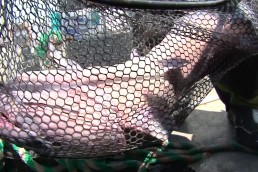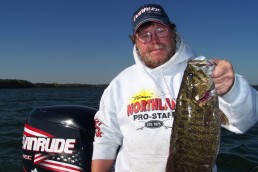Fish ‘in the Moment,’ Rather than Rely on Memories
SHARE THIS POST
“Fishing memories” is a term used by avid anglers when the only reason you’re in a particular area is because you’ve caught fish there before. We’ve all been guilty of this.
Oh sure, you’ll stumble into fish once in a while if you go back to the same place every single outing. But if the environment is not right in that hot spot of yours, the catching will simply suffer. Catching walleyes and other fish with any kind of consistency is more a matter of paying attention to the factors involved for that time of year, and not only what the weather is that day or week, but it has been like beforehand. Also, is the spawn early or late? What are the water temperatures the day you’re there and before? Is there forage or a major bug hatch happening and when?
As you can see, a lot dictates where you’ll find the fish in spring. Whether you’re on a reservoir, natural lake, river system or one of the Great Lakes, your “hot spot” is more than likely only a hot spot during certain times of year.
The congregation, early on
There was a Professional Walleye Trail (PWT) tournament held many springs ago on South Dakota’s Lake Francis Case in 2007, which is a perfect example of how not only the water temperatures affected the spawn of the walleyes that roam within this impoundment of the Missouri River but the moon phase as well.
I had fished this man-made lake many times, but never so early in the year. In this case and that year, the tournament was held the end of the first week of April. To be blunt, had I fished the memories of where I’d caught fish in tournaments past, I’d never have placed as high as I did, which was sixth place in a field of over 100 boats. Instead, I paid close attention to the every-changing temperatures of the water the couple weeks I was there in addition to the entire environment around me both during pre-fishing and tournament time. The water temperatures, how long those water temperatures held steady, the moon phase and the congregation of spawning walleye, etc., all dictated where the fish were as well would be later on there.
There was unseasonably warm air in the area the week before tournament time, which heated the water quickly and had the fish moving up and out of their deep-water winter haunts and onto rocks in shallower water. With this, water temperatures went from tickling the freezing mark into the mid- to upper 40s in no time and stayed there for at least a week. A full moon was also in phase while the waters warmed, thus the steady rise in temperatures and perfect lunar event was the textbook combination for the rituals of spawning to commence.
But then came the day before the tournament, and a major cold front moved in with arctic air blasting its way into the area. Normally, a cold front of this magnitude would have the walleyes hightailing it back down into deeper water and bellying to the bottom. This time, however, I took note from what I saw on my Lowrance sonar—the fish were reacting differently. Instead of migrating back into the depths, the fish stayed shallow and kept on spawning, despite water temperatures cooling nearly 10 degrees. Had the water only warmed up for a couple days and then cooled off with another moon phase overhead, the walleyed would have then held off on spawning, moved off of the first breakline offshore and sulked until the next warm up. As a whole, I had paid attention to the environment of the water, and not just the day of the tournament but the whole week before. And, I didn’t fish the places from my memories of tournaments past, but rather which was in the moment before me and found new water. And it paid off big time.
Are you enjoying this post?
You can be among the first to get the latest info on where to go, what to use and how to use it!
Despite the weather
I caught a lot of fish in that particular brutal South Dakota cold. My technique was to position my Lund offshore just far enough so that I could cast a 3-inch Berkley PowerBait Minnow fished on a 1/8-ounce Northland Buck-Shot Rattle Jig right at the shoreline then jig it back to the boat. The hits were subtle; the bitter cold made feeling strikes difficult. The super-low stretch of 6-pound-test Berkley FireLine really helped me detect bites though, and I sprayed Blakemore’s Real Magic onto my Abu Garcia’s filled spool and Fenwick rods’ guides so the frozen line would cast better.
Post-spawn spread
Even though they’re bellied to the bottom after spawning, walleyes get real hungry afterward, eating to regain their strength. Anything from minnows to young-of-the-year trout and salmon to smelt to suckers and alewives to aquatic insects, there are food sources as these fish move off the first breaks of offshore areas. After migrating back from the rivers, creeks and off rock-strewn shorelines and into the main-lake basins, the biggest hen walleyes tend to spread out rather than school-up. Thus, fishing the same old spots this time of year can make for poor results. In the Great Lakes, large inland lakes and reservoirs, the fish could be anywhere from near pier heads adjacent to river mouths they may have spawned within to miles offshore or into the main lake.
This post-spawn period is when I’ll crank up my 9.9 4-stroke kicker and cover as much water as I can with artificial baits that mimic minnows. I’ll use a three-way rig—a heavy bell sinker on a dropper line tied to a three-way swivel and a Rapala on 4 feet of leader line trailing behind. This is trolled near the bottom and directly behind the boat. Trolling leadcore in conjunction with Church Tackle’s inline planer boards is a great near-bottom tactic when covering water too. While pulling these rigs for walleyes hugging the bottom, I’ll also put out Shad Raps and troll them behind the planer boards for fish that might be suspended.
This time of year I tend to roll slowly, at 1.4 to 1.7 mph. If I don’t get bit, I’ll slow down even more. And whether it’s used as my mainline when tolling or as a leader for my leadcore, I use Berkley’s 12-pound-test Trilene XT.
Follow the food
As spring wanes, walleyes become even more focuses on finding food. But now the fish can be found wherever baitfish and bugs are congregating, either suspended high in the water column near structure or tight to these during cold fronts. I’ll troll crankbaits now with a tighter wiggle when fish are suspended, and at higher speeds. I’ll use lures higher and directly behind a boat or out to the sides with inline planer boards. If fish are not responding to my speed, I’ll either speed up or slow down until I get bit.
Faded memories
Fishing memories? That’s not a problem if the conditions are just right in places you’ve caught them before. But for more consistency, pay attention to the environment around you, finding out what it was like before and later when you’re at your location. Watch those water temperatures before and during your day on the lake, and fish where the fish are that day. Sure, that seems like a no-brainer, but sometimes we can forget.
MWO
SHARE THIS POST
Did you enjoy this post?
You can be among the first to get the latest info on where to go, what to use and how to use it!
Mark Martin
Mark Martin is a professional walleye tournament angler and instructor with the Ice Fishing School/Vacation series. For more information, check out his website at markmartins.net or fishingvacationschool.com.


